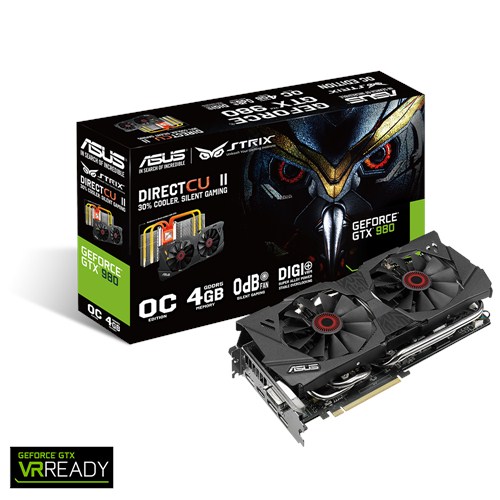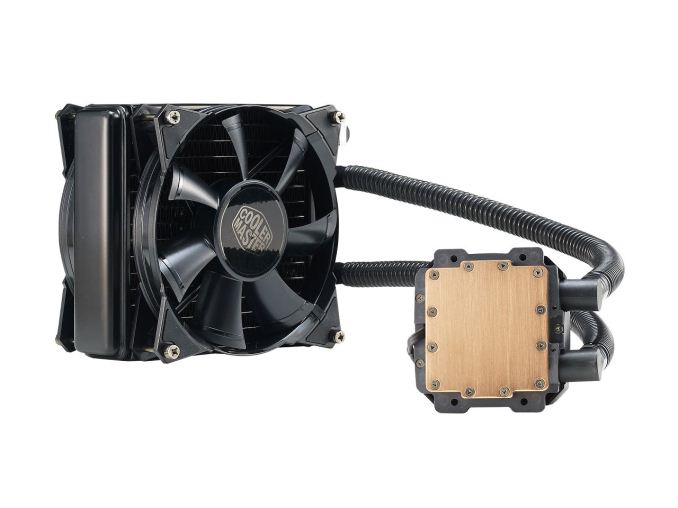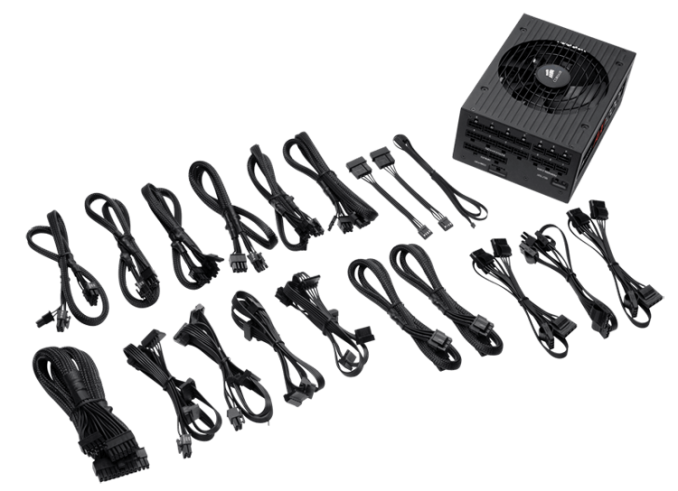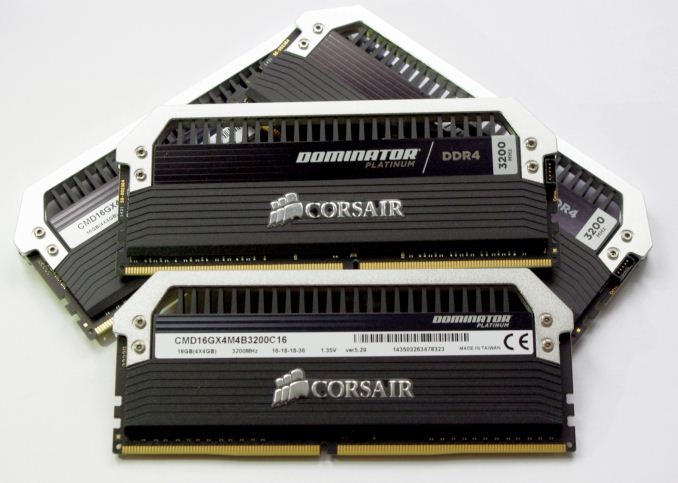The Intel Core i5-7600K (91W) Review: The More Amenable Mainstream Performer
by Ian Cutress on January 3, 2017 12:01 PM ESTTest Bed and Setup
As with every CPU launch, there are a number of different directions to take the review. We have dedicated articles comparing the IPC of the new Kaby Lake line of CPUs, as well as a look into overclocking performance as a whole. We have had almost every desktop-class CPU family since Sandy Bridge tested in our benchmark suite, although only the latest have been retested. Due to timing, we were able to test all three of the new Kaby Lake-K processors, and retest the several Skylake processors, however we do have some CPU data for comparison for Haswell, Ivy Bridge, and Sandy Bridge. It will interesting to see how the CPU performance out-of-the box has adjusted over the last five generations.
As per our testing policy, we take each CPU and place it in a suitable high-end motherboard and equip the system with a suitable amount of memory running at the processor maximum supported frequency. This is also typically run at JEDEC subtimings where possible. It is noted that some users are not keen on this policy, stating that sometimes the maximum supported frequency is quite low, or faster memory is available at a similar price, or that the JEDEC speeds can be prohibitive for performance. While these comments make sense, ultimately very few users apply memory profiles (either XMP or other) as they require interaction with the BIOS, and most users will fall back on JEDEC supported speeds - this includes home users as well as industry who might want to shave off a cent or two from the cost or stay within the margins set by the manufacturer. Where possible, we will extend out testing to include faster memory modules either at the same time as the review or a later date.
| Test Setup | |
| Processor | Intel Core i7-7600K (Retail Stepping), 91W, $303 4 Cores, 8 Threads, 3.8 GHz (4.2 GHz Turbo) |
| Motherboards | ASRock Z270 Extreme4 MSI Z270 Gaming M7 |
| Cooling | Cooler Master Nepton 140XL |
| Power Supply | OCZ 1250W Gold ZX Series Corsair AX1200i Platinum PSU |
| Memory | Corsair DDR4-2400 C15 2x8 GB 1.2V or G.Skill Ripjaws 4 DDR4-2400 C15 2x8 GB 1.2V |
| Memory Settings | JEDEC @ 2400 |
| Video Cards | ASUS GTX 980 Strix 4GB MSI GTX 770 Lightning 2GB (1150/1202 Boost) ASUS R7 240 2GB |
| Hard Drive | Crucial MX200 1TB |
| Optical Drive | LG GH22NS50 |
| Case | Open Test Bed |
| Operating System | Windows 7 64-bit SP1 |
Readers of our reviews will have noted the trend in modern motherboards to implement a form of MultiCore Enhancement / Acceleration / Turbo (read our report here) on their motherboards. This does several things, including better benchmark results at stock settings (not entirely needed if overclocking is an end-user goal) at the expense of heat and temperature. It also gives in essence an automatic overclock which may be against what the user wants. Our testing methodology is ‘out-of-the-box’, with the latest public BIOS installed and XMP enabled, and thus subject to the whims of this feature. It is ultimately up to the motherboard manufacturer to take this risk – and manufacturers taking risks in the setup is something they do on every product (think C-state settings, USB priority, DPC Latency / monitoring priority, overriding memory sub-timings at JEDEC). Processor speed change is part of that risk, and ultimately if no overclocking is planned, some motherboards will affect how fast that shiny new processor goes and can be an important factor in the system build.
Many thanks to...
We must thank the following companies for kindly providing hardware for our multiple test beds. Some of this hardware is not in this test bed specifically, but is used in other testing.
Thank you to AMD for providing us with the R9 290X 4GB GPUs. These are MSI branded 'Gaming' models, featuring MSI's Twin Frozr IV dual-fan cooler design and military class components. Bundled with the cards is MSI Afterburner for additional overclocking, as well as MSI's Gaming App for easy frequency tuning.
The R9 290X is a second generation GCN card from AMD, under the Hawaii XT codename, and uses their largest Sea Islands GPU die at 6.2 billion transistors at 438mm2 built at TSMC using a 28nm process. For the R9 290X, that means 2816 streaming processors with 64 ROPs using a 512-bit memory bus to GDDR5 (4GB in this case). The official power rating for the R9 290X is 250W.
The MSI R9 290X Gaming 4G runs the core at 1000 MHz to 1040 MHz depending on what mode it is in (Silent, Gaming or OC), and the memory at 5 GHz. Displays supported include one DisplayPort, one HDMI 1.4a, and two dual-link DVI-D connectors.
Further Reading: AnandTech's AMD R9 290X Review
Thank you to ASUS for providing us with GTX 980 Strix GPUs. At the time of release, the STRIX brand from ASUS was aimed at silent running, or to use the marketing term: '0dB Silent Gaming'. This enables the card to disable the fans when the GPU is dealing with low loads well within temperature specifications. These cards equip the GTX 980 silicon with ASUS' Direct CU II cooler and 10-phase digital VRMs, aimed at high-efficiency conversion. Along with the card, ASUS bundles GPU Tweak software for overclocking and streaming assistance.
The GTX 980 uses NVIDIA's GM204 silicon die, built upon their Maxwell architecture. This die is 5.2 billion transistors for a die size of 298 mm2, built on TMSC's 28nm process. A GTX 980 uses the full GM204 core, with 2048 CUDA Cores and 64 ROPs with a 256-bit memory bus to GDDR5. The official power rating for the GTX 980 is 165W.
The ASUS GTX 980 Strix 4GB (or the full name of STRIX-GTX980-DC2OC-4GD5) runs a reasonable overclock over a reference GTX 980 card, with frequencies in the range of 1178-1279 MHz. The memory runs at stock, in this case 7010 MHz. Video outputs include three DisplayPort connectors, one HDMI 2.0 connector and a DVI-I.
Further Reading: AnandTech's NVIDIA GTX 980 Review
Thank you to Cooler Master for providing us with Nepton 140XL CLCs. The Nepton 140XL is Cooler Master's largest 'single' space radiator liquid cooler, and combines with dual 140mm 'JetFlo' fans designed for high performance, from 0.7-3.5mm H2O static pressure. The pump is also designed to be faster, more efficient, and uses thicker pipes to assist cooling with a rated pump noise below 25 dBA. The Nepton 140XL comes with mounting support for all major sockets, as far back as FM1, AM2 and 775.
Further Reading: AnandTech's Cooler Master Nepton 140XL Review
Thank you to Corsair for providing us with an AX1200i PSU. The AX1200i was the first power supply to offer digital control and management via Corsair's Link system, but under the hood it commands a 1200W rating at 50C with 80 PLUS Platinum certification. This allows for a minimum 89-92% efficiency at 115V and 90-94% at 230V. The AX1200i is completely modular, running the larger 200mm design, with a dual ball bearing 140mm fan to assist high-performance use. The AX1200i is designed to be a workhorse, with up to 8 PCIe connectors for suitable four-way GPU setups. The AX1200i also comes with a Zero RPM mode for the fan, which due to the design allows the fan to be switched off when the power supply is under 30% load.
Further Reading: AnandTech's Corsair AX1500i Power Supply Review
Thank you to Crucial for providing us with MX200 SSDs. Crucial stepped up to the plate as our benchmark list grows larger with newer benchmarks and titles, and the 1TB MX200 units are strong performers. Based on Marvell's 88SS9189 controller and using Micron's 16nm 128Gbit MLC flash, these are 7mm high, 2.5-inch drives rated for 100K random read IOPs and 555/500 MB/s sequential read and write speeds. The 1TB models we are using here support TCG Opal 2.0 and IEEE-1667 (eDrive) encryption and have a 320TB rated endurance with a three-year warranty.
Further Reading: AnandTech's Crucial MX200 (250 GB, 500 GB & 1TB) Review
Thank you to G.Skill for providing us with memory. G.Skill has been a long-time supporter of AnandTech over the years, for testing beyond our CPU and motherboard memory reviews. We've reported on their high capacity and high-frequency kits, and every year at Computex G.Skill holds a world overclocking tournament with liquid nitrogen right on the show floor. One of the most recent deliveries from G.Skill was their 4x16 GB DDR4-3200 C14 Kit, which we are planning for an upcoming review.
Further Reading: AnandTech's Memory Scaling on Haswell Review, with G.Skill DDR3-3000
Thank you to Corsair for providing us with memory. Similarly, Corsair (along with PSUs) is also a long-time supporter of AnandTech. Being one of the first vendors with 16GB modules for DDR4 was a big deal, and now Corsair is re-implementing LEDs back on its memory after a long hiatus along with supporting specific projects such as ASUS ROG versions of the Dominator Platinum range. We're currently looking at our review pipeline to see when our next DRAM round-up will be, and Corsair is poised to participate.
Further Reading: AnandTech's Memory Scaling on Haswell-E Review

















70 Comments
View All Comments
FourEyedGeek - Tuesday, January 10, 2017 - link
Wow, such a rebel, you are inspiring!pentiuman - Sunday, March 26, 2017 - link
I agree w/ Bullwinkle! I have referred to this website occasionally, but just joined this website to make this post. I have 2 systems, and the older one runs a Core2-quad Q6600 - that idles under 5 % usage, according to Task Manager! It's on both Windows XP and Windows 7 on seperate HD's. I really like my XP install for several reasons: 1. My old HP Laser printer works w/ it, 2. XP doesn't take up much space - I have dozens of programs installed on a 120GB drive. 3. It is very familiar to previous Window versions, so I don't have to learn even more new ways just to do the same tasks. 4. Although Microsoft left us w/ no further updates, XP's support by hardware manufacturers continue! Next time you're at a tech store, read the driver compatibilities. 5. Although I use mainly CD's, I have more digital music rights and options! 6. WinXP works w/ my backup software, my Microsoft Office suites, and old games. 7. Despite what Microsoft wants you to believe, an up to date antivirus program, reasonably careful Internet-based program usage, and customized program installs, means I hardly ever have any virus or malware issues.- Microsoft is up to something, when they give away Windows 10, and prevent us from using anything but Windows 10, starting w/ Kaby Lake and AMD Ruyzen. Why? Question authority.
MonkeyPaw - Tuesday, January 3, 2017 - link
You are using an operating system that has been EOLed on hardware that has been EOLed. Besides, XP was the first OS to start phoning home, so you might want to hunt down a copy of Windows 2000.Bullwinkle J Moose - Wednesday, January 4, 2017 - link
MonkeyPawVolume Licensed copies of XP-SP1 did not contain the Phone Home activation DRM and could easily be slipstreamed to SP2 or SP3 versions
Any remaining microsoft components could easily be blocked with an aftermarket firewall so there is really no need for Windows 2000 just to avoid phoning home
End of Life for XP is the day I can no longer block a persistent threat
End of Life for 7/8 and 10 is the day they were released as I still cannot block the persistent threats imposed by the weaponized spyware and malware that Microsoft simply calls DRM for Legal Reasons
Achaios - Wednesday, January 4, 2017 - link
Dear, Bullwinkle J Moose, since you are so concerned with NSA snooping on you, I'd like to inform you that North Korea and China are the two regions of the world where Windows XP is the most widely used operating system.I don't even need to explain to you why NK and China are prime targets of electronic surveillance and espionage by the US of A and other actors. That means, Windows XP is the worse operating system to run as almost every single espionage tool in the US arsenal is made specifically to target Windows XP PC's, amongst other OS' and so-called "unknown" OS'.
Bullwinkle J Moose - Wednesday, January 4, 2017 - link
Dear Achaiosevery single espionage tool in the US arsenal will fail on a Windows XP box that is set up properly and used in the same manner
It takes a lot of research to get it right and have reliable/repeatable results and it is not recommended for all the wannabe experts at this site, but the results speak for themselves
NO persistent threat has been found that can wreck this XP installation and I check out new threats quite often
It is a read only OS when using Driveshield
Flash and java are disabled and Silverlight and Net Framework are not allowed!
Everything including the antivirus is blocked from sending or receiving in the aftermarket firewall
Only a secure browser is allowed Internet access
Nothing is allowed to update over the Internet!
If I need AV updates, I download the complete updated installer to a clean system and install it offline
Portable utilities are available to close most remaining security vulnerabilities quickly
It is not used for banking or other sensitive input
That's what a fresh copy of Linux LIVE is for!
But it is great for studying malware/extortionware and any other threats without getting hosed by the worst of the worst hackers on the planet
It is SAFE for what it does!
For other things (gaming or banking), I have several other operating systems on several thumbdrives, hard drives and SSD's
I can switch eSATA and USB drives quickly while rebooting and never rely on dualboot drives for reliability purposes
Leaving 1st boot drive blank in the BIOS means it will just boot to whatever drive is connected (SATA OR USB)
maximumGPU - Wednesday, January 4, 2017 - link
let me get this right. You have a severely locked down EOL OS that has very limited usability except for niche things like studying malware and you're claiming kaby lake is a waste of money because you can't make it work on that os?hope this will help:
INTEL AND THE REST OF THE WORLD DOESN'T CARE ABOUT YOUR USE CASE, THIS PRODUCT IS NOT INTENDED FOR YOU.
ps: i seriously doubt any foreign government gives a sh*t about your pron viewing habits either. Stop trolling.
Shadow7037932 - Wednesday, January 4, 2017 - link
>every single espionage tool in the US arsenal will fail on a Windows XP box that is set up properly and used in the same mannerIf you believe that, I got a bridge to sell you...
tech6 - Wednesday, January 4, 2017 - link
@Bullwinkle Moose: If you're still running Windows XP then you are so vulnerable that you are not blocking ANY malware, let alone state sponsored players.close - Wednesday, January 4, 2017 - link
@Bullwinkle J Moose, I have an XP that I desperately want to keep using but I need assistance in securing it. Mind if you give me a hint with what you've done? I run SP3 but if needed I can upgrade to SP2.